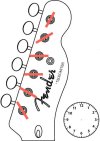mr_fender
Axe-Master
Non-double locking trem systems are the primary beneficiaries of locking tuners. They're not going to make as much difference on a hardtail guitar other than faster string changes.
Kluson style tuners on Fenders are a snap. Just pull the string tight and cut it about 2 inches past the post (2 tuning posts down) for the wound strings and about 2.5 to 3 inches past on the plain strings. Poke it down in the hole, bend it over clockwise and wind away. They're also super fast to remove the string too once you fully slack them. Just pull up and all the winds come right off.
Kluson style tuners on Fenders are a snap. Just pull the string tight and cut it about 2 inches past the post (2 tuning posts down) for the wound strings and about 2.5 to 3 inches past on the plain strings. Poke it down in the hole, bend it over clockwise and wind away. They're also super fast to remove the string too once you fully slack them. Just pull up and all the winds come right off.
Last edited:

